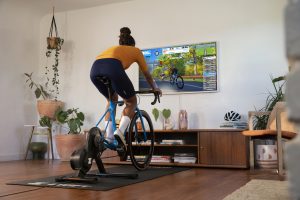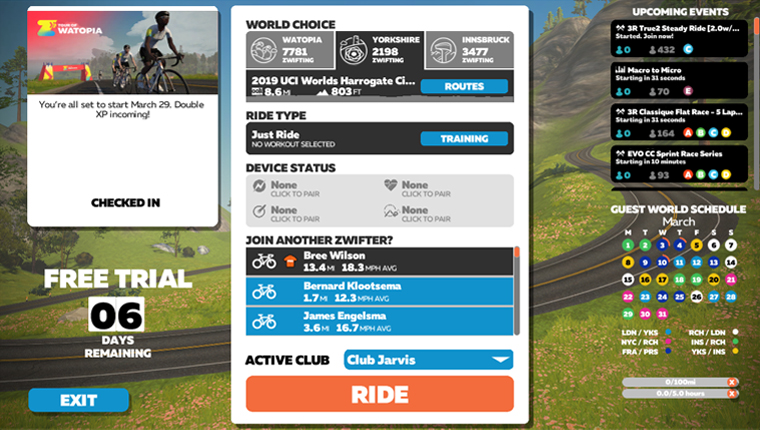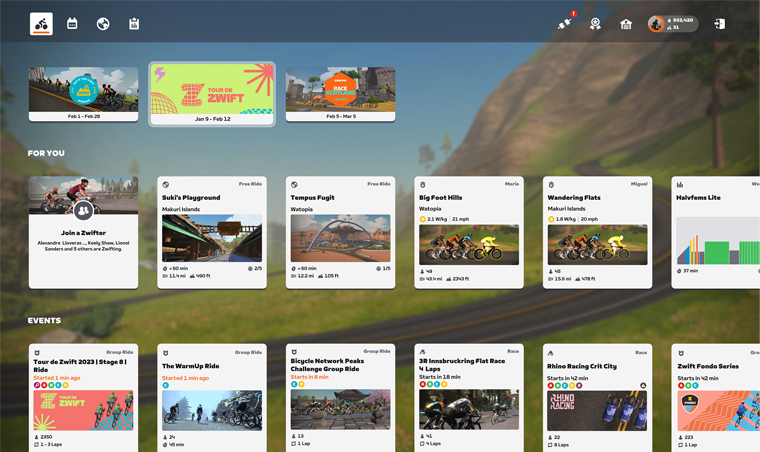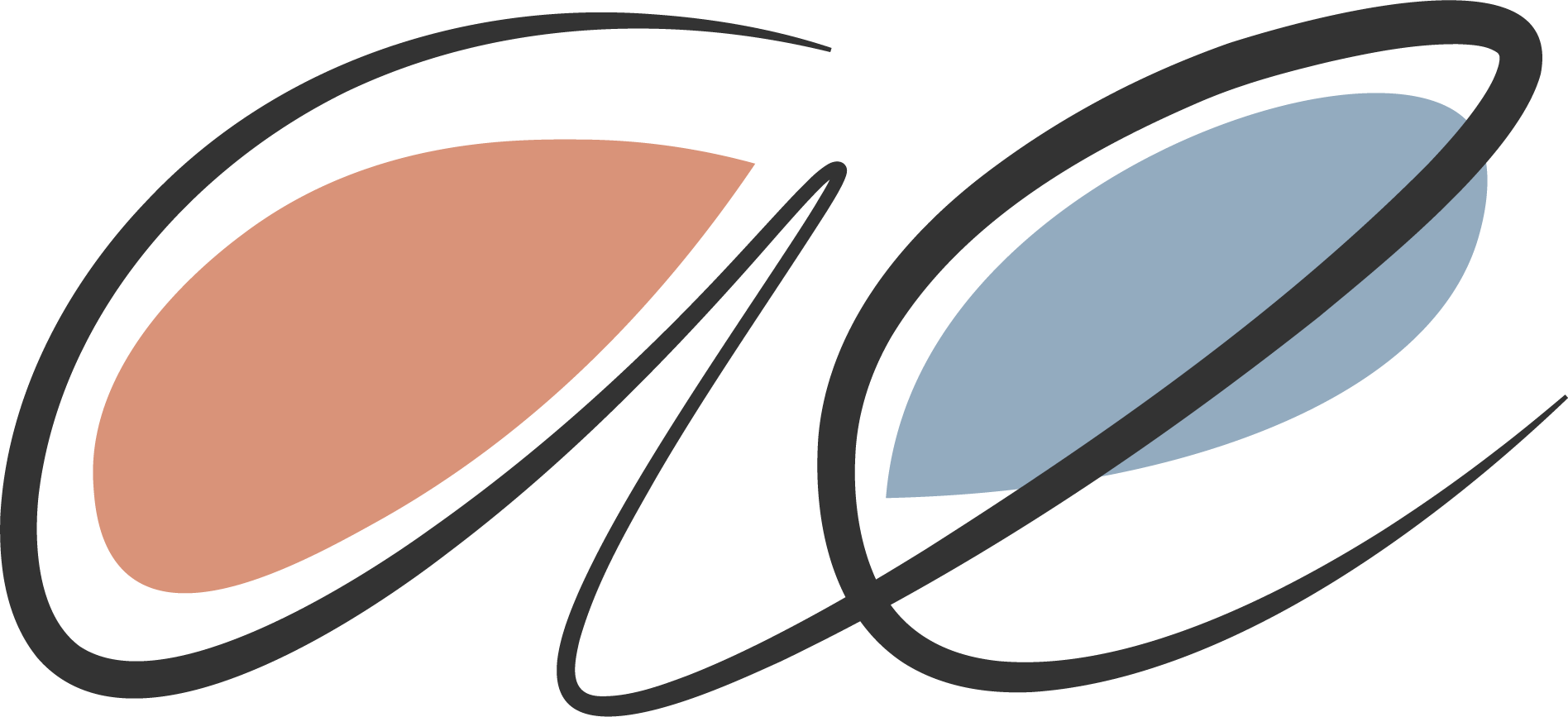One project I’m especially proud to have led at Zwift was the home screen update. The project was already in progress but lacked clear product direction and leadership. I stepped in as Senior Product Manager to bring it back on track and ensure it met its seasonal deadline. This timing was crucial, as Zwift usage peaks during the winter months when training outdoors becomes more challenging for cyclists and runners.
Zwift is an MMO fitness platform for cyclists and runners, that enables people to interact, train, and compete in a virtual world.

Zwift’s Home Screen
Before the redesign, the home screen—where players choose an activity and launch into the game—presented significant usability issues and opportunities for improvement.
This is the old home screen players interacted with:

Challenges with the legacy home experience for Zwifters:
- Participating in social activities required significant effort, typically done outside of the game via websites or a companion app.
- Navigating the UI, particularly on certain platforms, was cumbersome and frustrating.
- Simple tasks, like adjusting settings before a workout or viewing achievements, required unnecessary workarounds.
- Finding relevant information to choose suitable activities was difficult.
- It required heavy development effort to update features based on player feedback and requests.
What we delivered:

The Results
37%
Increase in the median number of activities for new members during their first seven days.
5.1pp
Increase in members joining social activities, a key indicator for retention on the platform.
Project Objectives
Create a scalable, user-friendly home experience for Zwifters, laying the foundation for ongoing design and tech iteration across the game.
Business Goals
As Zwift, we can..
- measure feature success through improved player behavior tracking.
- integrate new UI middleware and design system for continuous interface and feature updates.
- facilitate social participation to boost player retention and subscriptions by helping players connect with the right people and group events.
Player Goals
As as Player, I can..
- quickly access and start planned activities.
- discover relevant activities when I don’t have a plan.
- easily manage game settings, bike customization, and workout planning before entering the game.
- effortlessly use Zwift on my preferred platform.
My Contributions
Led a Cross-Functional Team
I acted as team lead, project advocate, and primary contact for internal teams and stakeholders. I led a core group of engineers, designers, and QA while managing dependencies with the platform team for multi-stage rollout technology, an external studio for implementation, and the data team for analytics integration.
After joining the project, I prioritized improving collaboration, streamlining communication, and strengthening dependency management to ensure smoother execution across all teams. I provided better visibility into milestones and release dates, giving everyone the information they needed to support the project. The result was a more effective and motivated team excited to deliver this massive update to our players.
Ownership and Prioritization
As the product owner, I defined milestones and prioritized features to align with player needs and Zwift goals. I focused on balancing features to attract new users while delivering value to existing players. With the seasonal deadline in mind, I led the team in selecting features that would maximize impact within our available time and resources.
Stakeholder Alignment
I delivered key updates to stakeholders, securing buy-in for critical decisions and features. The project involved balancing trade-offs across engineering for UI middleware integration, product design for a new UI component design system, collaboration with the data team on player behavior tracking, and alignment with business partners focused on player acquisition and growth goals.
Managed External Studio Partnership
I led collaboration with an external development team, aligning milestones, priorities, and staffing needs. By establishing regular check-ins and WIP build reviews, I streamlined communication and improved feature quality, ensuring more predictable cross-platform delivery.
Improved Alignment Through Regular Feature Reviews
To improve alignment with the project’s vision across internal and external teams, I established regular feature reviews. By encouraging an open feedback loop with the design and development teams, I ensured our features met our design goals and prioritized the player experience. We also incorporated targeted user testing and internal playtest results into our reviews, allowing us to iterate early in development.
Led Staged Rollout to Validate Features
I developed and implemented a phased rollout to smaller cohorts on targeted platforms, allowing us to validate the new UI across systems while gathering data to measure success against our targets. I proactively collaborated with marketing and community teams to align with publishing goals and address concerns. To facilitate the initial launch, I created a transparent release plan with clear go/no-go points, enabling marketing, community, and support teams to adjust their plans independently and reducing the need for constant updates.
Measuring Success
One hypothesis for the new home screen was that connecting players for activities fosters social connections and a sense of community, leading to increased retention and subscriptions. By rolling out to cohorts of first-time users and comparing their behaviors and subscription rates to those using the old home screen, we validated our hypothesis. This increased internal confidence in the design and allowed us to expand the rollout to more players across more cohorts and platforms.
